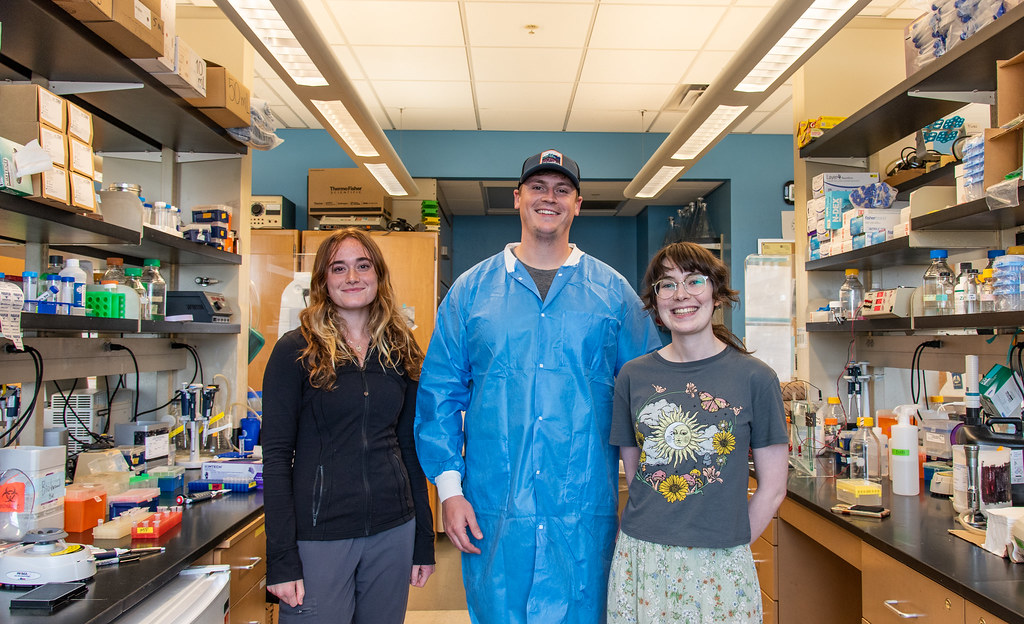
Shrinking the Target: Developing Cancer Therapies
As cancer cells multiple and spread, doctors face finding treatments that destroy tumors while doing the least amount of damage.
This search for precision in cancer therapies is for good reason. It takes only a few minutes in a chemotherapy clinic to see the detriment of cancer drugs on the rest of the body.
“The issue with chemotherapeutic drugs is they have a lot of off-target effects,” said Brian Thomas, a MD-Ph.D. candidate working in the Donald Burke lab. “Our goal is to make them more targeted towards cancer cells using aptamers.”
Careful targeting of treatment is one important goal of cancer researchers, and aptamers are one way scientists at Bond Life Sciences Center work toward that goal.
Aptamers are short, single stranded DNA or RNA molecules that can bind to a target when it folds into a 3D structure. They can either serve as a vehicle for a cancer drug — delivering it to cancer cells while avoiding healthy cells — or bind itself to a cell’s receptors to interfere with its natural response.
In the Burke lab, the target of choice is epidermal growth factor receptors (EFGR), a protein that helps cells grow and spread. Mutations — mistakes in the DNA that makes this protein — can increase the number of EFGRs and cause cells to grow out of control, ultimately leading to cancer. The goal is to test how to best ensure aptamers successfully bind to cancer cells so they can be destroyed.

Michaela Beedy, an undergraduate research assistant in the Burke lab works alongside Thomas. She is focusing on pairing aptamers with the chemotherapy drug doxorubicin to better target mutated cancer cells.
“Doxorubicin is really good at killing cells that are fast proliferating, which includes cancer cells and epithelial cells,” Thomas said. “It is also really good at killing cardiomyocytes, which is not a good thing.”

The goal is to get doxorubicin to kill the cancer cells but to leave healthy cells like those heart muscle cells alone. Ideally, the cancer can be treated without posing too much risk to other vital organ functions.
Additionally, patients who undergo chemotherapy often develop resistance to a drug as newly mutated cancer cells become immune to the old therapy. That is why she is focusing on addressing specific aspects of what causes mutations.
Margaret Beecher, another Burke undergraduate, is testing a different hunch that could work in conjunction with Beedy’s work. Beecher investigates if dimeric aptamers might provide more of a targeted effect.
“Monomeric aptamers only have one spot that can bind to EFGRs while dimeric have two,” Beecher said. “Because there are two spots, this increases its avidity.”
Avidity is the combined strength of binding, and it is critical in getting a drug to interact with its appropriate target. This could be applied to Beedy’s doxorubicin approach.
“If we end up killing more EFGR-mutant positive cancer by using aptamer-doxorubicin treatment we could bring in the dimeric aspect as well to increase the effect of the therapy,” Beedy said.
The treatment in question is aptamer-doxorubicin conjugates, essentially a combination of the three.
Even if Beedy’s approach isn’t as effective at killing more mutant cells, Beecher’s research still comes in handy.
“If we saw less of a targeted effect because the aptamer wasn’t binding as well, maybe adding that dimeric aspect to it can help bring it back up to be on par with other treatments.,” Beecher explained.
New cancer therapies couldn’t come at a better time. Right now, the U.S. is in the midst of one of the worst cancer drug shortages in history due to manufacturing issues, leaving Thomas optimistic about the work in his lab.
“Right now, we’re doing in vitro…doing things in a dish. The ultimate goal is to get these treatments into animal models and, subsequently into humans to then finally create new therapies for patients in need.”

